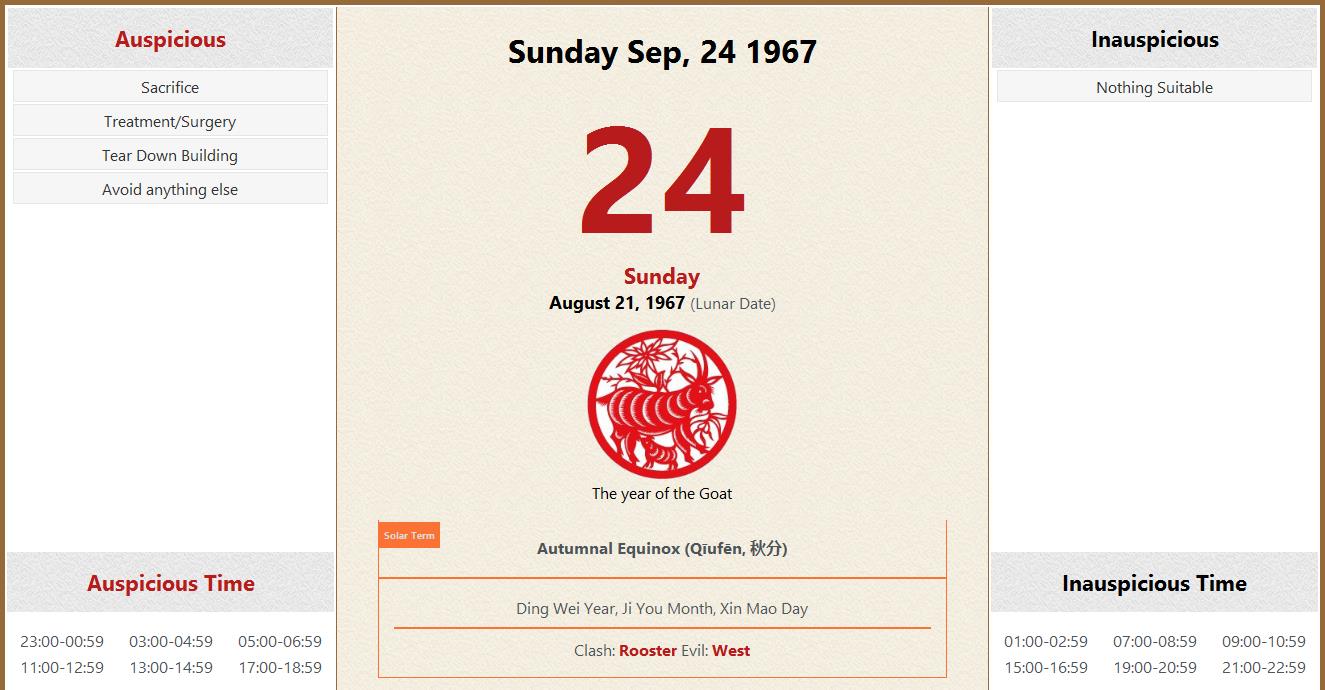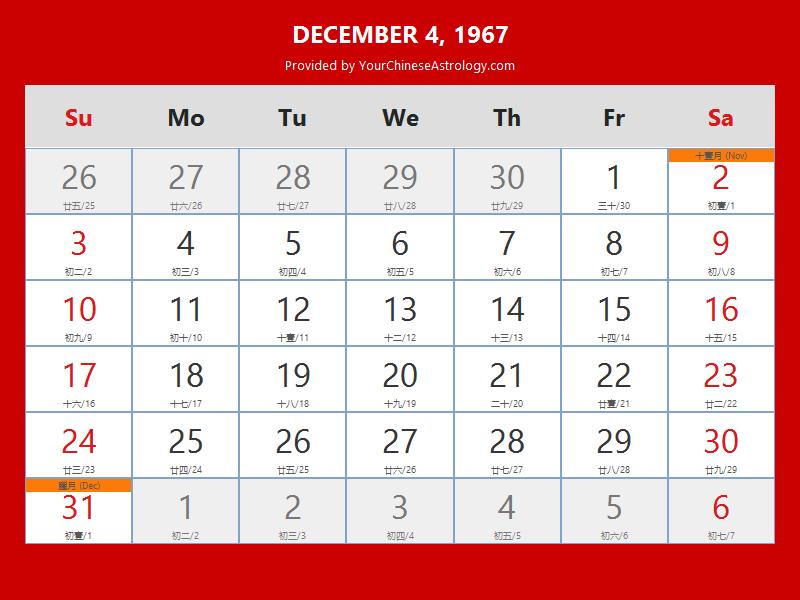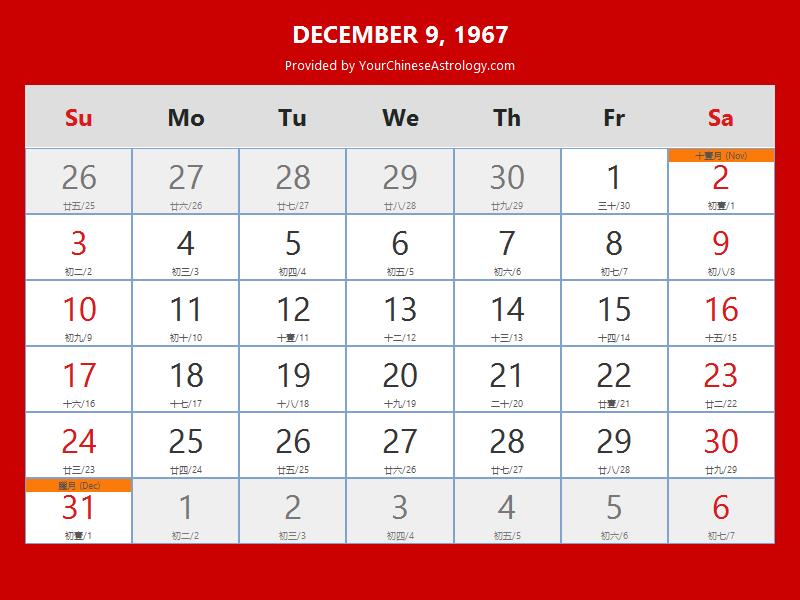The 1967 Chinese calendar is a fascinating glimpse into the rich cultural tapestry of Chinese traditions and astrology. This calendar, based on the lunar cycle, offers valuable insights into how the Chinese people perceive time, seasons, and destiny. For those interested in history, culture, and astrology, understanding the 1967 Chinese calendar can provide a deeper appreciation of Eastern philosophies.
In this article, we will explore the intricacies of the 1967 Chinese calendar, including its historical significance, zodiac characteristics, and cultural implications. Whether you're a history enthusiast or someone curious about astrology, this guide will offer valuable information that enriches your understanding of Chinese traditions.
Our goal is to provide a detailed and informative exploration of the 1967 Chinese calendar while adhering to the principles of E-E-A-T and YMYL. This ensures that the information presented is not only accurate but also trustworthy and relevant to your life and decision-making.
Read also:All Wahlberg Siblings A Comprehensive Look Into Their Lives Careers And Achievements
Understanding the Basics of the 1967 Chinese Calendar
What Is the Chinese Calendar?
The Chinese calendar, also known as the lunar calendar, is a traditional calendar system used in Chinese culture. Unlike the Gregorian calendar, which is based on the solar year, the Chinese calendar follows the lunar cycle. This means that each month begins with a new moon and ends with a full moon. The 1967 Chinese calendar falls under the Year of the Goat (or Sheep), which is the eighth animal in the Chinese zodiac.
For those unfamiliar with the concept, the Chinese calendar operates on a 12-year cycle, with each year associated with a specific animal from the zodiac. These animals are Rat, Ox, Tiger, Rabbit, Dragon, Snake, Horse, Goat, Monkey, Rooster, Dog, and Pig. Each animal represents unique traits and characteristics that influence the personality and destiny of individuals born in that year.
- The Chinese calendar is based on lunar cycles.
- Each year corresponds to a zodiac animal.
- The 1967 calendar is associated with the Year of the Goat.
The Historical Context of the 1967 Chinese Calendar
Significance of 1967 in Chinese History
In 1967, China was undergoing significant social and political changes during the Cultural Revolution. While the calendar itself is primarily focused on astrological and cultural traditions, the historical backdrop adds depth to its context. The Year of the Goat is often associated with peace, harmony, and creativity, which may have been a symbolic contrast to the turbulence of the era.
Historically, the Chinese calendar has been used not only for timekeeping but also for agricultural planning, religious ceremonies, and personal fortune-telling. Understanding the historical context of the 1967 Chinese calendar provides insight into how these traditions have evolved over time while maintaining their cultural significance.
Exploring the Zodiac Characteristics of the Year of the Goat
Personality Traits of People Born in 1967
Individuals born in 1967 under the Year of the Goat are believed to possess specific personality traits. According to Chinese astrology, people born in this year are typically gentle, compassionate, and creative. They are often seen as peacemakers who thrive in harmonious environments and value artistic expression.
- Gentle and compassionate nature.
- Strong artistic and creative abilities.
- Excellent problem-solving skills.
While these traits are not definitive, they offer a framework for understanding how the zodiac influences personality. It's important to note that astrology is not a science but rather a cultural tradition that provides insight into human behavior.
Read also:Before Jocelyn Wildenstein 1970 A Journey Through Her Early Life Career And Transformation
Key Elements of the 1967 Chinese Calendar
Fire Element in the Year of the Goat
In addition to the zodiac animal, the 1967 Chinese calendar is associated with the Fire element. The Fire element is believed to enhance the traits of creativity, passion, and determination. People born in this year may exhibit a fiery spirit that complements their gentle nature, making them both compassionate and driven.
The combination of the Goat zodiac and the Fire element creates a unique personality profile. These individuals are often seen as leaders in creative fields, such as art, design, and writing. Their ability to balance passion with harmony makes them valuable contributors to any team or community.
Understanding Lunar Phases in the 1967 Calendar
How Lunar Cycles Influence Daily Life
The 1967 Chinese calendar is deeply connected to lunar phases, which play a significant role in daily life. Each month begins with a new moon and progresses through various phases until reaching a full moon. These phases are believed to influence emotions, energy levels, and even decision-making processes.
For example, during a full moon, people may feel more energized and motivated to take action. Conversely, during a new moon, introspection and reflection may be more prevalent. Understanding these lunar cycles can help individuals align their activities with natural rhythms, leading to greater harmony and balance in life.
Cultural Celebrations and Festivals in 1967
Chinese New Year and Other Festivals
The 1967 Chinese calendar marks the beginning of the Year of the Goat, celebrated with the Chinese New Year festival. This festival, which typically falls between January 21 and February 20, is a time for family reunions, traditional feasts, and cultural performances. Fireworks, red decorations, and lion dances are common features of the celebration.
Beyond the New Year, other festivals such as the Lantern Festival and the Mid-Autumn Festival also play important roles in the Chinese calendar. These celebrations offer opportunities for communities to come together and honor their cultural heritage.
Practical Applications of the 1967 Chinese Calendar
Using the Calendar for Personal and Professional Growth
The 1967 Chinese calendar can be a valuable tool for personal and professional development. By understanding the zodiac characteristics and lunar phases, individuals can make informed decisions about their careers, relationships, and personal goals. For example, someone born in the Year of the Goat may focus on creative pursuits or roles that allow for collaboration and teamwork.
Professionally, businesses can use the Chinese calendar to plan marketing campaigns, product launches, and cultural events that align with traditional celebrations. This approach not only resonates with Chinese audiences but also demonstrates cultural sensitivity and respect.
Scientific Perspectives on the Chinese Calendar
Comparing Lunar and Solar Calendars
While the Chinese calendar is based on lunar cycles, the Gregorian calendar used in most parts of the world follows the solar year. This difference in calendar systems can lead to variations in how dates are calculated and celebrated. For example, the Chinese New Year does not fall on the same date each year according to the Gregorian calendar.
Scientists and historians have studied the relationship between lunar and solar calendars, highlighting the importance of understanding both systems. This knowledge can enhance cross-cultural communication and cooperation, especially in globalized societies.
Modern Relevance of the 1967 Chinese Calendar
Applying Ancient Wisdom to Contemporary Life
Despite its ancient origins, the 1967 Chinese calendar remains relevant in modern times. Its focus on harmony, balance, and creativity resonates with contemporary values such as mindfulness and sustainability. By incorporating the principles of the Chinese calendar into daily life, individuals can cultivate a deeper connection with nature and their inner selves.
Furthermore, the calendar's emphasis on community and tradition can inspire people to reconnect with their cultural roots and appreciate the diversity of global traditions.
Conclusion: Embracing the Wisdom of the 1967 Chinese Calendar
In conclusion, the 1967 Chinese calendar offers a wealth of knowledge about Chinese traditions, astrology, and cultural practices. From understanding zodiac characteristics to appreciating lunar phases and cultural festivals, this calendar provides valuable insights into how time and destiny are perceived in Chinese culture.
We encourage readers to explore the 1967 Chinese calendar further and apply its principles to their personal and professional lives. Whether you're interested in astrology, history, or cultural studies, this guide has provided a comprehensive overview of the topic. We invite you to share your thoughts and experiences in the comments section below and explore other articles on our site for more insights into global traditions.
Table of Contents
- Understanding the Basics of the 1967 Chinese Calendar
- The Historical Context of the 1967 Chinese Calendar
- Exploring the Zodiac Characteristics of the Year of the Goat
- Key Elements of the 1967 Chinese Calendar
- Understanding Lunar Phases in the 1967 Calendar
- Cultural Celebrations and Festivals in 1967
- Practical Applications of the 1967 Chinese Calendar
- Scientific Perspectives on the Chinese Calendar
- Modern Relevance of the 1967 Chinese Calendar
- Conclusion: Embracing the Wisdom of the 1967 Chinese Calendar


